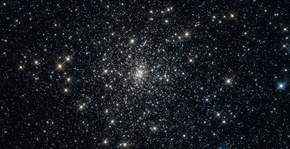| NGC 6256 | |
|---|---|
 NGC 6256 as seen through the Hubble Space Telescope NGC 6256 as seen through the Hubble Space Telescope | |
| Observation data (J2000 epoch) | |
| Constellation | Scorpius |
| Right ascension | 16 59 32.68 |
| Declination | −37° 07′ 17.1″ |
| Distance | 22 kly (6.8 kpc) |
| Apparent magnitude (V) | 11.3 |
| Apparent dimensions (V) | 7′ |
| Physical characteristics | |
| Absolute magnitude | −7.15 |
| Estimated age | 13.0±0.5 Gyr |
| Other designations | NGC 6256, GCL 49.1, ESO 391-SC6 and vdB-Hagen 208 |
| See also: Globular cluster, List of globular clusters | |
NGC 6256 is a globular cluster of stars in the southern constellation of Scorpius. It was discovered by the Scottish astronomer James Dunlop on Aug 2, 1826. In J. L. E. Dreyer's New General Catalogue annotation it is described as, "very faint, very large, very gradually bright in the middle, well resolved clearly consisting of stars." The cluster is located at a distance of 22 thousand light-years (6.8 kpc) from the Sun.
This is an ancient cluster with an estimated age of about 13 billion years; it was formed during the very early stages of assembly of the Milky Way galaxy. The cluster is orbiting within the galactic bulge with a low orbital eccentricity. It is heavily reddened by extinction due to interstellar gas and dust. The structure is very concentrated at the center, showing a post core collapse morphology.
The HR diagram for this cluster displays two sequences of blue straggler stars, which are the products of stellar mergers. The bluer sequence is well-defined and narrow, most likely being generated over a short time span. The redder sequence is more sparse, being the result of a continuous process of formation. It is hypothesized that the bluer sequence was formed around the time of the cluster's core collapse about one billion years ago; an event that made stellar collisions more likely.
The cluster contains a millisecond X-ray pulsar, designated IGR J16597-3704.
References
- ^ Di Criscienzo, M.; et al. (February 2006). "RR Lyrae-based calibration of the Globular Cluster Luminosity Function". Monthly Notices of the Royal Astronomical Society. 365 (4): 1357–1366. arXiv:astro-ph/0511128. Bibcode:2006MNRAS.365.1357D. doi:10.1111/j.1365-2966.2005.09819.x. S2CID 17838243.
- ^ Cadelano, M.; et al. (May 2020). "Digging for Relics of the Past: The Ancient and Obscured Bulge Globular Cluster NGC 6256". The Astrophysical Journal. 895 (1). id.54. arXiv:2004.06131. Bibcode:2020ApJ...895...54C. doi:10.3847/1538-4357/ab88b3.
- O'Meara, Stephen James (2013). Deep-Sky Companions: Southern Gems. Cambridge University Press. p. 331. ISBN 9781107015012.
- Frommert, Hartmut. "NGC 6256". Students for the Exploration and Development of Space. Retrieved 2024-05-23.
- "NGC 6256". SIMBAD. Centre de données astronomiques de Strasbourg. Retrieved 2024-05-23.
- Seligman, Courtney. "NGC Objects: NGC 6250 - 6299". Celestial Atlas. Retrieved 2024-05-23.
- Terzan, A.; Lelievre, G. (December 1973). "The Cluster NGC 6256". Astronomy and Astrophysics. 29: 431. Bibcode:1973A&A....29..431T.
- Ortolani, S.; et al. (April 1999). "Colour-magnitude diagrams of the post-core collapse globular clusters NGC 6256 and NGC 6717 (Palomar 9)". Astronomy and Astrophysics Supplement. 136 (2): 237–243. Bibcode:1999A&AS..136..237O. doi:10.1051/aas:1999210.
- Cadelano, Mario; et al. (December 2022). "Discovery of a Double Sequence of Blue Straggler Stars in the Core-collapsed Globular Cluster NGC 6256". The Astrophysical Journal. 941 (1). id. 69. arXiv:2211.02671. Bibcode:2022ApJ...941...69C. doi:10.3847/1538-4357/aca016.
- Tetarenko, A. J.; et al. (February 2018). "A Radio Frequency Study of the Accreting Millisecond X-ray Pulsar, IGR J16597-3704, in the Globular Cluster NGC 6256". The Astrophysical Journal. 854 (2). id. 125. arXiv:1801.05778. Bibcode:2018ApJ...854..125T. doi:10.3847/1538-4357/aaa95a.
External links
 Media related to NGC 6256 at Wikimedia Commons
Media related to NGC 6256 at Wikimedia Commons